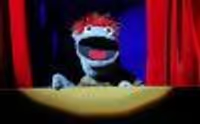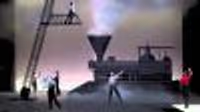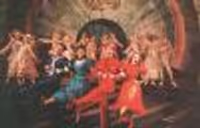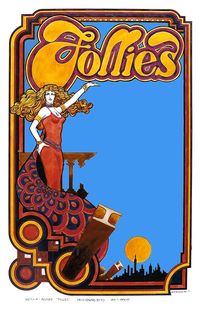FOLLIES 1971 Video Footage (and some Merrily 1981)
#50FOLLIES 1971 Video Footage
Posted: 5/21/11 at 7:42pm
It's from delagrandejatte's photostream
http://www.flickr.com/photos/28698051@N08/sets/72157607260354041/with/2852598508/
#52FOLLIES 1971 Video Footage
Posted: 5/22/11 at 9:57pmBoris Aronson and Florence Klotz should be awarded Sainthood.
#53FOLLIES 1971 Video Footage
Posted: 5/22/11 at 10:51pmIf only the Pope liked Sondheim as much as he likes Prada...
TheBatBoy
Chorus Member Joined: 1/5/11
#54FOLLIES 1971 Video Footage
Posted: 5/23/11 at 12:05am
I've been listening to the soundboard recording and I've become a huge fan. Forgive me if it sounds like a dumb question:
Back in the 70's how did they mic shows? I'm assuming that they didn't use body mics for performers then. When I'm listening to the Follies recording I'm hearing stomps which leads me to believe that they mounted floor mics everywhere into the set. Is this correct?
Any insight would be greatly appreciated. Thanks!
#55FOLLIES 1971 Video Footage
Posted: 5/23/11 at 12:16amPJ, thank you so much for those pictures! I'll admit, I can't say I'm as devoted to Follies as some here (as Sondheim shows go, Sweeney Todd is really my Follies- been obsessed with it since I was 11), but as someone who was born long after the original production, it's incredible to see photos of a show that I find really fascinating.
#58FOLLIES 1971 Video Footage
Posted: 5/23/11 at 7:41am
Oh thanks for that link, Chewy. I love this one:

And doesn't this one speak volumes about the relationship between these geniuses?

#59FOLLIES 1971 Video Footage
Posted: 5/23/11 at 7:49am
I didn't know Kurt Peterson had such an informative website:
http://www.jameswilliamproductions.com/Pages/follies_tsr.html
#60FOLLIES 1971 Video Footage
Posted: 5/23/11 at 11:25am
pj, Boris Aronson's model of the Loveland set shows wood ribs in the fan-like portals. Since you saw the original production 5 times, do you remember if the portals actually FANNED open, or did they just fly in from upstage to downstage as other photos of the sequence suggest?
(I know Boris DID use the fanning-open idea later for the tree Gedde Wattanabe climbed in Pacific Overtures for "Someone in a Tree". That was a true coup-de-theatre when the bare tree trunk (of the old man) suddenly burst into stunnning pink blossoms for the boy's memory with the simple opening of the gorgeously painted fan mounted atop it.)
Leading Actor Joined: 12/31/69
#61FOLLIES 1971 Video Footage
Posted: 5/23/11 at 12:12pmThose pictures are absolutely outstanding--thanks for the link!
#62FOLLIES 1971 Video Footage
Posted: 5/23/11 at 1:36pm
I'm going through about 15 DVD's that I've gotten over the years with all the footage posted here and more and I'm going to try to compile them into one long dvd. Before I do that though, I was wondering if there was any footage anywhere of "Too Many Mornings" or "Don't Look at Me"?
Updated On: 5/23/11 at 01:36 PM
#63FOLLIES 1971 Video Footage
Posted: 5/23/11 at 4:24pmcharles: I was about to answer "Yes!" because the Loveland reveal was so breathtaking, but I actually think the fans flew in already opened.
AwesomeDanny
Broadway Legend Joined: 7/30/09
#64FOLLIES 1971 Video Footage
Posted: 5/23/11 at 5:13pm
"Back in the 70's how did they mic shows? I'm assuming that they didn't use body mics for performers then. When I'm listening to the Follies recording I'm hearing stomps which leads me to believe that they mounted floor mics everywhere into the set. Is this correct?"
If you read Everything Was Possible by Ted Chapin (highly recommended, a really great book), I'm sure many of your questions about the show will be answered, this on included. I'm too lazy to look it up, but I believe he said that the first body mic was used in the 1960s, but they weren't common much later. In this show, they used floor mics and hid a bunch of mics in the set, pointed at where people would be singing.
Also, just to add to the confusion, in Everything Was Possible, he does say that there was a camera filming part of a tech rehearsal or something in Boston, though he noted that the following day, Dorothy's wig was changed. So, if this is different from the footage now believed to be from LA, it would be interested to see what has come of this actual Boston footage.
#65FOLLIES 1971 Video Footage
Posted: 6/5/11 at 9:34am
Excellent-quality clips of three numbers from the Loveland sequence, posted last week:
Loveland:
http://youtu.be/QoBRHhRMCOI
Buddy's Blues:
http://youtu.be/P7rM3ozL8m8
Lucy/Jessie:
http://youtu.be/AmexU4Qd0HM
I believe it's the same footage we've seen before but better-quality video.
#66FOLLIES 1971 Video Footage
Posted: 6/7/11 at 11:37am
Here's another recently added clip of the Montage from 1971 via youtube-
http://www.youtube.com/watch?v=5fvkHB3MA4s
The previously posted (striking) photo of Boris Aronson's set (the final scene) can be found in THE THEATRE ART OF BORIS ARONSON by Frank Rich and Lisa Aronson, now out of print, but usually (and affordably) available through sites like Alibris and ABE books. It's a coffee table-style volume covering Aronson's entire career, and well worth any price.
lizabombs
Chorus Member Joined: 5/13/11
#67FOLLIES 1971 Video Footage
Posted: 6/7/11 at 12:16pmI've never seen a photograph of the "Rain on the Roof" couple. Does one exist? Must be the only musical number I've never seen a photo of.
Phyllis Rogers Stone
Broadway Legend Joined: 9/16/07
#68FOLLIES 1971 Video Footage
Posted: 6/7/11 at 12:29pm
I don't think I have, either. It's like they really ARE ghosts.
I feel like of the last four clips posted, all the footage is new to me except for some of the Broadway Baby and Ah Paree clips. Any time it looks like it's coming from stage left, I guess, where it's really sharp quality, I've never seen. I think I've seen some of those Lucy and Jessie clips, but the Loveland and Buddy's Blues looks new to me.
Watching the clip of the montage makes me wonder if the finale was changed for the Kennedy Center because of Regine. Maybe it was just too much for her. I didn't totally hate the way they did it in DC, but the original ending is a lot more joyous, I think.
#69FOLLIES 1971 Video Footage
Posted: 6/7/11 at 1:30pm

Maybe the reason there are no pictures of the Whitmans from the 1971 production is that they are haunted by the REAL ghost of Dortha Duckworth, who was fired and replaced by Marcie Stringer.
She had made her Broadway debut in 1929 at the Vanderbilt Theater on 48th Street, in a play called White Flame, which lasted only 8 performances.
Dortha Duckworth is the real ghost of Follies.
Phyllis Rogers Stone
Broadway Legend Joined: 9/16/07
#71FOLLIES 1971 Video Footage
Posted: 6/7/11 at 3:44pmSeems so. I would say that, after being fired from Follies, Dortha Duckworth went insane and had to be institutionalized...but I'd be making it up.
Phyllis Rogers Stone
Broadway Legend Joined: 9/16/07
Broadway Legend Joined: 12/31/69
#73FOLLIES 1971 Video Footage
Posted: 6/7/11 at 4:05pmI heard the same story about Anna Maria Alberghetti in Carnival.
Phyllis Rogers Stone
Broadway Legend Joined: 9/16/07
Videos






